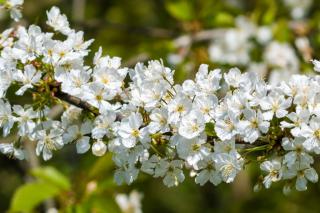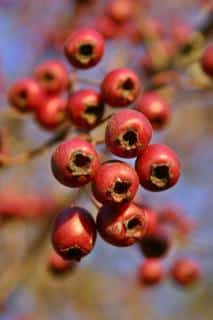

Hawthorn is a shrub often used for defensive hedges, and it is also very ornamental.
A summary of Hawthorn facts
Name – Crataegus
Family – Rosaceae
Type – tree, bush
Height – 16 to 25 feet (3 to 8 meters)
Exposure – full sun, part sun
Soil – ordinary
Foliage – deciduous
Flowering – April-May
Its leaves, discrete flowering and cute berries are its main attractions.
Planting in fall or in spring is best for hawthorn, but, as for all shrubs, the ideal period is always fall.
Choosing to plant in fall makes root development possible before winter, and growth in spring will be stronger.
If you plant in spring, remember to water regularly after planting to ensure it settles in well.
Hawthorn is very easy to care for, and only requires little attention when it is correctly settled in.
Pruning hawthorn isn’t needed unless it’s part of a hedge. If it is, you’ll have to prune it regularly.
If it isn’t pruned, your hawthorn can grow quite large and its branches can get very thick.

Pick them during the blooming, especially at the beginning when there are only very few leaves.
The right time to harvest the leaves is spring, when the leaves are still quite young.
Hawthorn berries must be harvested in fall or winter.
There are many ornamental hawthorn varieties such as:

Both hardy and easy to care for, this tree will also give you satisfaction since it will adapt to the soil and climate of where you live.
Leaves take on varied hues from spring to fall, and magnificent berries will decorate your hawthorn from the end of summer until the beginning of winter.
Even though they’re edible, hawthorn berries taste bland and mealy when raw, but birds go wild about them.
Hawthorn berries, those typical little red marbles, are edible. The shrub’s leaves can be eaten, too.
These berries are thus used to make jelly and jams and the leaves are used for infusions.
The berries have relaxing and laxative properties, properties that are quite common in natural healing preparations.
Here is a video with expert advice about hawthorn flowers and berries:
If you need to discourage people from crossing through your yard, use hawthorn because its thorns are the real thing!
Your comment is awaiting moderation.
What hawthorn bush grows best in zone 5b? I only seem to be able to find zone 7 or 8 bushes.
Thank you
Do hawthorn bushes like acid fertilizer?
Hi Nancy, hawthorn prefers neutral soil, but it can still grow in acidic and alkaline soil. For instance, it won’t do as well in heath soil which has a very acidic pH (pH 4 to 5). If all you have is acidic fertilizer, you can go ahead and use it once since that won’t change the soil pH much. But make sure the next time you use fertilizer, it’s more on the neutral side.
If you’re in doubt, you can get a cheap pH test for your soil (read about how to test your soil pH here). Hawthorn likes pH 6.0 to 7.5. If you’re already in the higher range (7+), having a little acid fertilizer won’t hurt. If however you’re already near 5.0 or 6.0, then better find another more neutral or alkaline fertilizer to use.
I have an old Hawthorn bush it is march here in Oklahoma and we had a very unusual cold winter this year. I fed the bush a few weeks ago and watered but noticed today that all the leaves are brown is it possible that the extreme cold has killed it this year? Am 84 and hate the idea of trying to find someone to remove it. Is there hope that it may recover?
Hello Lorena, I’m sorry to hear that your hawthorn has turned brown! However, it might not be dead yet. You can try snipping a branch off to check if the wood is brown and dry around the edges. If so, snip further into the tree. Hopefully at some point you’ll see a ring of fresh, green life just under the bark. That proves the tree is still alive and you can still hope for revival!
Normally hawthorn is very resistant to the cold – typically down to -10°F (-25°C). Did it get that cold this year in OK? If not, we can try thinking of other reasons it might have suffered.